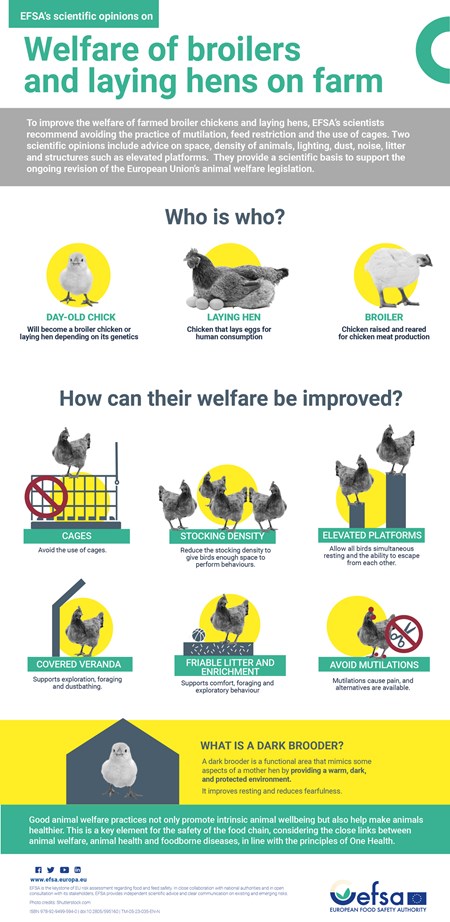EFSA (European Food Safety Authority) has just released a new report on the welfare of broiler chickens on farm, which provides a scientific basis to support the ongoing revision of the European Union’s animal welfare legislation, as part of the European Commission’s Farm to Fork strategy. The scientific opinion includes advice on stocking density of the animals, lighting, dust, noise, litter and structures such as elevated platforms.

The ”Welfare of broilers on farm” released on 21 February presents a comprehensive overview of the latest scientific findings on the welfare of broiler chickens kept in the most common husbandry systems used in the European Union. The findings and recommendations will feed into the revision of the EU animal welfare legislation, including the revision of the existing ‘Broiler Directive' (Council Directive 2007/43/EC) setting rules for the protection of broiler chickens kept for meat production.
The publication covers the general welfare of day-old chicks, broiler breeders and broiler chickens (chickens bred for meat) in different husbandry systems. The report identifies and describes 19 highly relevant welfare consequences of current production systems for broiler chickens, based on the severity, duration, and frequency at which they occur. These include bone lesions and locomotory disorders, heat stress, inability to perform comfort and exploratory behaviour, prolonged hunger, restriction of movement and inability to rest.
Main welfare hazards identified
The report describes the main welfare hazards on farm leading to each of the welfare consequences identified, and highlights measures to prevent, correct or mitigate them, with particular emphasis on the role of genetics, stocking density and litter quality.
The report states that the health and welfare status of broilers strongly depends on the genetics, and that breeds with better welfare and health outcomes must therefore be chosen.
Insufficient space allowance was also identified as a key hazard, with the maximum stocking density above which footpad dermatitis (FPD) score increases, walking ability reduces, and the expression of behavioural needs is impaired, identified as 11kg/m2.
Absence of, or poorly managed litter, inadequate light management, temperature control and lack of elevated structures were also identified as hazards.
The report introduces the concept of “Iceberg Indicators” - animal-based measures (ABMs) that are relevant to more than one welfare consequence. The report recommends that these important indicators, such as walking impairment, feather dirtiness, mortality rate, hock burns, footpad dermatitis, are included in any welfare assessment scheme.
Report recommendations
The report provides several detailed recommendations, including the following:
- Birds should never be housed in cages.
- A maximum stocking density of 11 kg/m2 should be applied to give the broilers the space they need to express natural behaviours, to rest properly and to support their health.
- Growth rate should be limited to a maximum of 50g/day to allow the broilers to maintain better health and be more active, and breeds with better welfare and health outcomes must be chosen.
- All forms of mutilations in broiler breeders should be avoided. Preventive measures should be in place to prevent the need for mutilations.
- Feed restriction in both day-old chicks and broiler breeders should be avoided by choosing the appropriate breeds and feed and management measures.
- Dry and friable litter should be provided from day one. Litter quality should be monitored and maintained, and new litter material should be added throughout the rearing period to support comfort as well as exploratory and foraging behaviours.
- Covered verandas, or wintergardens, should be provided to broilers and breeders to allow birds to choose between different temperatures, light conditions, and substrate quality and to promote foraging, exploratory and comfort behaviours.
- Perches, elevated platforms, and dark brooders should be provided to create functional areas and environmental enrichment for the birds.
- Harmonised assessment methods should be implemented across Europe for assessing several animal-based measures, such as mortality on farm, wounds, carcass condemnation, and foot pad dermatitis in broilers at slaughter.

EFSA recommendations supports European Chicken Commitment
Compassion welcomes this new EFSA report as it gives additional robust, scientific evidence to support all our key recommendations on broiler welfare and supports the main requirements of the European Chicken Commitment (ECC).
Adopting slower growing breeds with better welfare outcomes, reducing stocking density, enriching the housing environment with perching structures and pecking substrates, are all fundamental criteria of the ECC, as well as key recommendations outlined in the EFSA report.
It is imperative that more producers and food companies sign up to the ECC and implement these key criteria to improve the lives of broiler chickens in their supply chain.
Find out more about the European Chicken Commitment here.